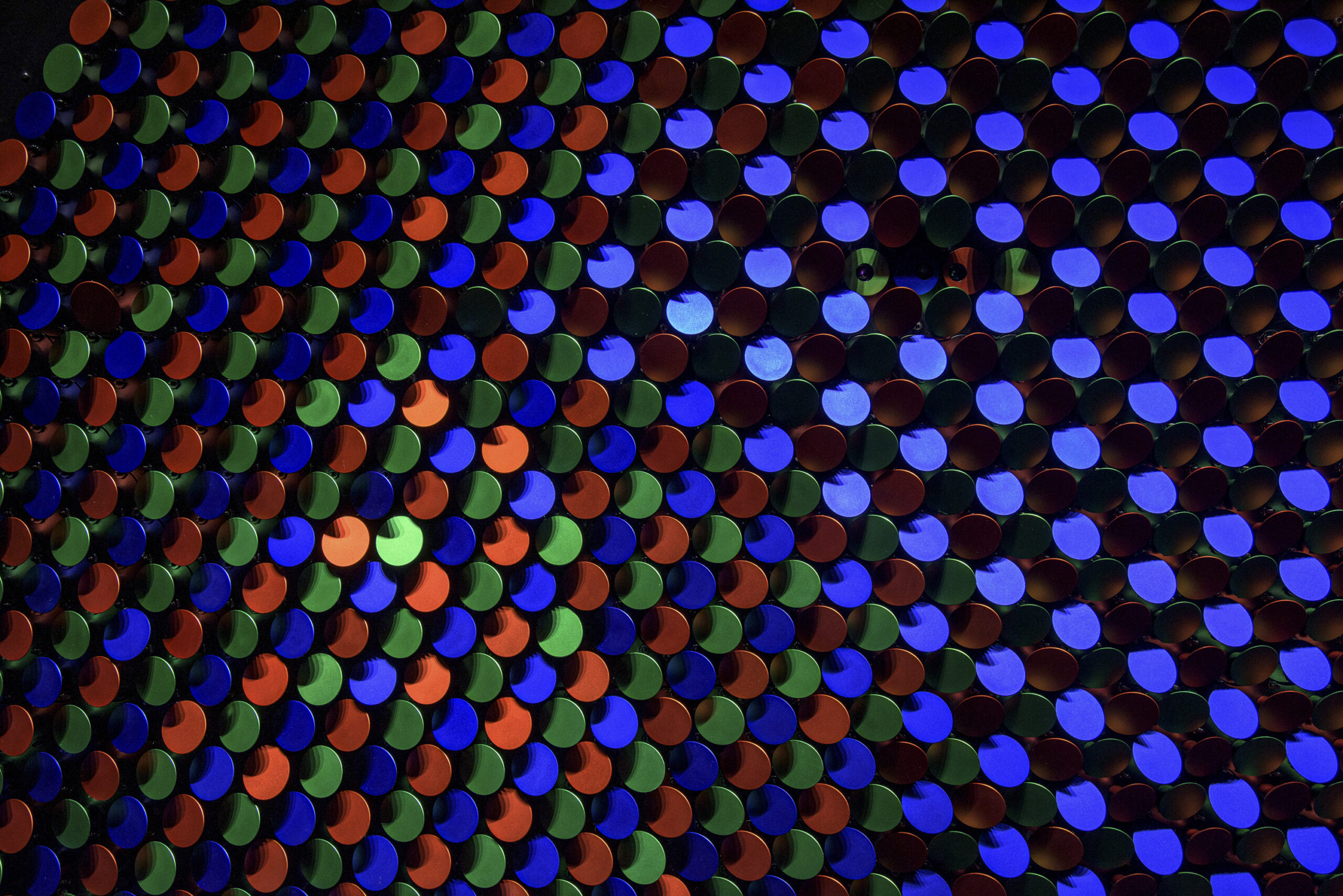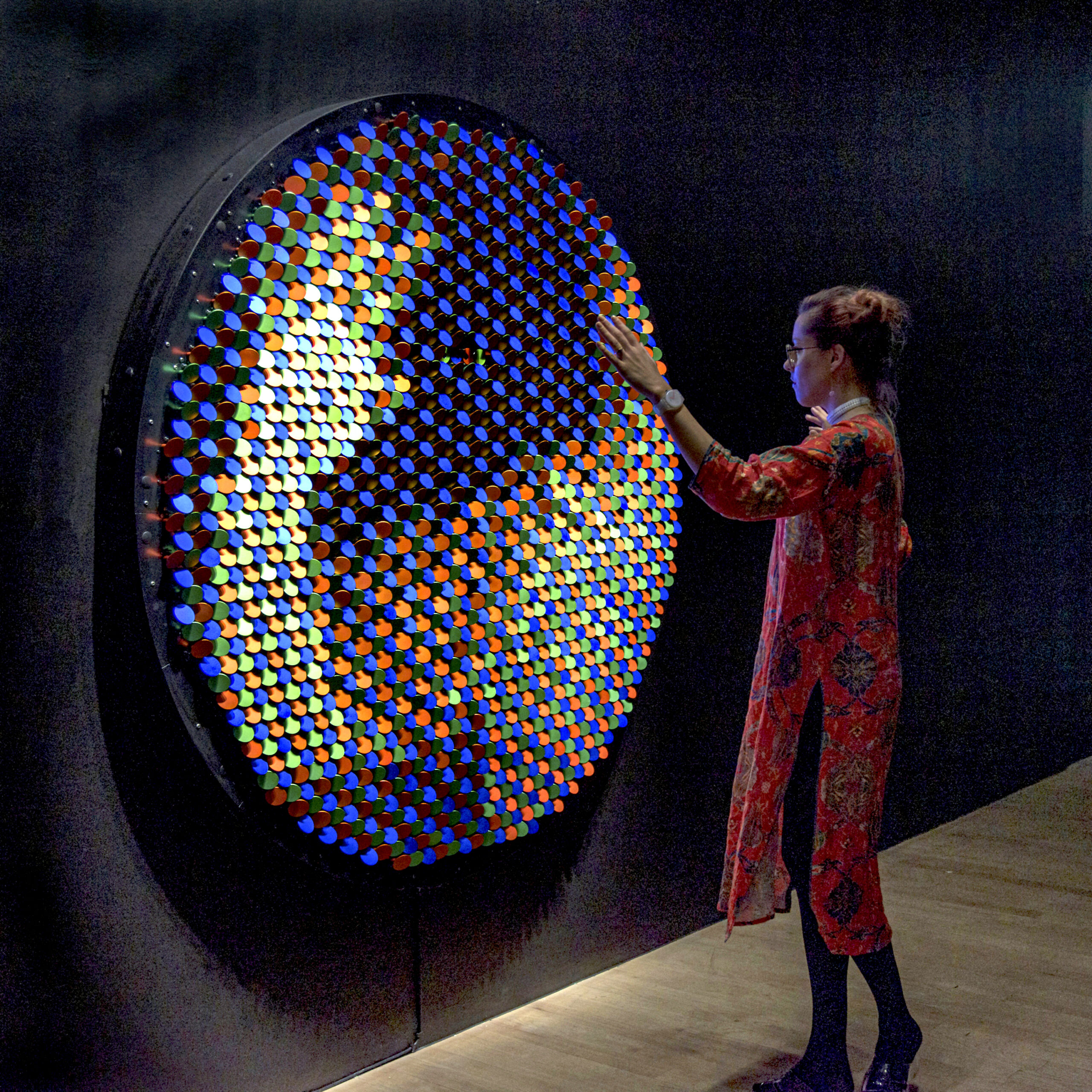
A new LSU Museum of Art exhibit encourages the viewer to become part of the art
At first glance, the digital and mechanical mirrored pieces in a new LSU Museum of Art exhibit may appear as blank screens or intricate puzzles. Yet, the true revelation lies in the moment you step before it.
Daniel Rozin’s “Mirror Mirror” is not merely an art exhibit; it’s a sensory adventure. Each sculpture inside the new exhibit, open now through March 3, is adorned with adjustable tiles or digital pixels that respond to your every move. The idea is to turn spectators into an active architect of the composition itself.
Rozin’s mirrors are crafted from recycled scraps, whimsical pom-poms and even brass materials traditionally used to make musical instruments. Almost like a wizard, he seamlessly blends mechanical components with cutting-edge computer software into his artful designs, which move and change alongside the person standing before them. His first mirror, made from 835 pine pieces, earned him recognition from Wired.
|
|
With digitized, interactive—and highly Instagrammable—art exhibits growing in popularity nationally, LSU MOA Chief Curator and Director of Programs Michelle Schulte believes “Mirror Mirror” will offer Baton Rouge a glimpse into an evolving genre.
“Rozin is a pioneer in pushing the boundaries of interactive art. He treats technology as his artistic medium, much like a painter uses a brush,” Schulte says. “His skill in allowing viewers to interact with a finished sculpture while concealing the mechanics, as demonstrated in the PomPom Mirror, sets him apart from other contemporary artists.”
Amidst extensive research and unwavering determination, the Jerusalem-born, New York-based artist painstakingly unraveled the secrets of the mirror, transforming the concept into a luminous interactive marvel—and he hopes his art inspires personal exploration with individuality as the centerpiece.
Here, the artist gives a window into his work.
Answers have been edited for clarity and brevity.
What was the initial inspiration that led to your mirror series?
My series of ‘Mechanical Mirrors’ has been evolving for 25 years, and each piece has its own little inspiration. As a whole, I would say that my curiosity about the creation of image and about the involvement of the viewer in the creation of my art are foundational to my art pieces.
Can you describe the technical elements and materials used to bring your pieces to life?
All of my mirrors, both software and mechanical pieces, share the underlying technology of connecting a camera to a computer and selectively displaying the image back to the viewer by some means. For the mechanical pieces, it means connecting hundreds of motors to the computer and manipulating these in a choreographed manner so they reproduce the image by manipulating some aspect of a material. In the case of my PomPom Mirror, it means pushing and pulling on 900 fur puffs, half-black and half-white, to reproduce a dynamic black-and-white image of the viewer.
How do you balance the interactive and aesthetic aspects of your art?
This is a very difficult balance and one that keeps many artists from engaging in interactive art. Artists are typically control freaks and want to maintain and control every aspect of their art. Having your art be interactive means leaving aspects of the piece open for the viewer to complete. It means relinquishing control and opening up your art to a possibility of being less than ideal under certain circumstances. This is a huge price to pay for an artist. Since viewer participation is such a foundational concept in my art, and also the source of much of my satisfaction, this balance is not that difficult for me.

What emotions or ideas do you hope viewers will take away from their experience with your artwork?
Art can be many things: serious, profound, sad, disturbing and important. When I watch people interact with my pieces, they almost always smile and sometimes jump up and down. I think my art gives joy to people.
What impact do you think interactive exhibits like ‘Mirror Mirror’ have on the way people engage with modern art?
I think interactive art flips over the paradigm of art viewing. When you look at traditional noninteractive art—say a masterpiece in a museum, the Mona Lisa in the Louvre—you see hundreds of people crowding to see a small protected artifact, and the overall feeling is that this artifact is very important and they are not. In a well-designed interactive art piece, the artifact is not that important—it is the viewer and this fleeting moment of interaction that are important. I find this healthier and more rewarding. My pieces are static and somewhat boring until a viewer stands in front of them—and then they fill up with motion, beauty and meaning.
SEE THE EXHIBIT
Daniel Rozin’s digital art exhibit, “Mirror Mirror,” runs Nov. 30, 2023, to March 3, 2024, at the LSU Museum of Art. For information and admission details, visit lsumoa.org.
|
|
|
